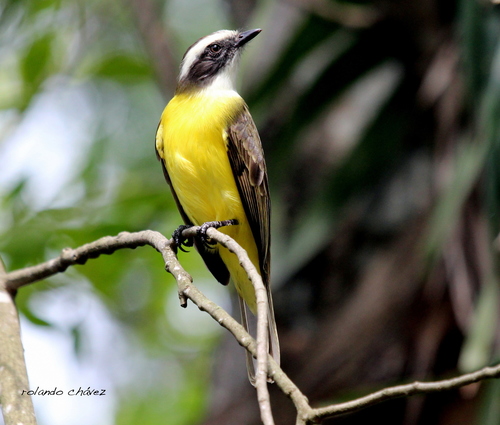
Social Flycatcher
The Social Flycatcher (*Myiozetetes similis*) is a vibrant and widespread passerine bird found throughout Central and South America. Known for its conspicuous bright yellow underparts and bold black-and-white head pattern, this flycatcher is a common sight in a variety of habitats, from forest edges to urban parks. Its name reflects its often gregarious nature, frequently seen in small groups. Ecologically, the Social Flycatcher plays a significant role in insect control, consuming a wide variety of arthropods. It is not currently considered globally threatened, adapting well to human-altered landscapes.
16-18 cm
Length
25-28 cm
Wingspan
Least Concern
Conservation Status
Distribution
The Social Flycatcher's range extends from southern Mexico through Central America and into much of South America, reaching as far south as northern Argentina and Uruguay. It is absent from the high Andes and the arid regions of western South America. They are generally non-migratory, although some local movements may occur in response to food availability.
Lifespan
The lifespan in the wild is not well documented, but likely ranges from 5-10 years, typical of small passerines.
Social Flycatcher's Habitat
Habitat Types
Forest edges, Open woodlands, Savannas, Riverine areas, Urban parks, Agricultural lands
Climate Zones
Tropical, Subtropical
Adaptations
Social Flycatchers exhibit a tolerance for a wide range of habitat types, contributing to their broad distribution. Their adaptability to human-modified landscapes, including urban areas, suggests a degree of behavioral plasticity and resilience.
Variations
Several subspecies of *Myiozetetes similis* are recognized, differing subtly in plumage coloration and size. These variations are often geographically defined, with distinct populations found in different parts of the species' extensive range.
Appearance
Breeding Plumage
Plumage is generally consistent year-round, with no significant differences between breeding and non-breeding seasons.
Seasonal Feather Changes
No significant seasonal variations.
Sex Based Plumage Differences
Males and females exhibit similar plumage.
Notable Features
Bright yellow underparts, Black crown with a concealed yellow or orange crown patch, Prominent white supercilium (eyebrow stripe), Dark brown upperparts
Diet and Feeding
Primary Foods
Insects, Spiders, Small fruits, Berries
Foraging Behavior
Social Flycatchers are primarily insectivorous, often observed sallying from perches to capture flying insects. They also glean insects from foliage and occasionally consume small fruits and berries. They are often seen foraging in small groups, sometimes mixed with other flycatcher species.
Specializations
Their relatively broad, flat bill is well-suited for capturing a variety of insects. Their agile flight allows for quick maneuvers to catch prey in mid-air.
Seasonal Diet Variations
Diet may shift slightly depending on the availability of insects and fruits. During periods of insect scarcity, they may consume more fruit.
Behavior
Social Structure
As their name suggests, Social Flycatchers are often found in small family groups or loose flocks, particularly outside the breeding season. They can be quite vocal and active.
Communication
Sharp, chattering calls, Rapid 'kweer-kweer-kweer' vocalizations, Visual displays involving crown feather erection
Migration
Generally non-migratory, although some local movements may occur in response to resource availability.
Territorial or Group Behaviors
During the breeding season, pairs defend territories around their nests. Outside of breeding, they are more tolerant of conspecifics and may form small foraging groups.
Conservation
Threats
Habitat loss due to deforestation, Pesticide use in agricultural areas
Protection Programs
Not specifically targeted by major conservation programs, but benefits from general habitat protection efforts.
Local National Laws
Protected under general wildlife protection laws in many countries within its range.
Population Trend
Stable
Population Estimates
While precise population estimates are difficult to obtain, the species is considered common and widespread throughout its range.
Interesting Facts
They often build their nests near wasp or bee nests.
This proximity may offer protection from predators, as the wasps or bees deter potential nest raiders.
They are known to mimic the calls of other bird species.
The purpose of this mimicry is not fully understood, but may be related to territorial defense or attracting mates.
The concealed crown patch is only visible during displays.
It used in courtship displays.
Faqs about Social Flycatcher
Are Social Flycatchers aggressive?
They can be territorial during the breeding season, defending their nests and surrounding areas from other birds. However, they are generally not considered overly aggressive towards humans.
Do Social Flycatchers visit bird feeders?
While they primarily eat insects, they may occasionally visit feeders offering fruit or suet, especially in areas where natural food sources are scarce.
What is the difference between a Social Flycatcher and a Great Kiskadee?
Although similar in appearance, the Great Kiskadee is larger, has a heavier bill, a rusty-rufous color on the wings and tail, and a different call.
Copyright @ Nature Style Limited. All Rights Reserved.
 English
English